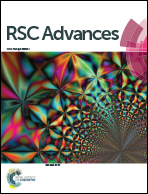Solvothermally synthesized graphene nanosheets supporting spinel NiFe2O4 nanoparticles as an efficient electrocatalyst for the oxygen reduction reaction†
Abstract
The production of efficient and low-cost electrocatalysts for the oxygen reduction reaction (ORR) is one of the key issues for the extensive commercialization of fuel cells. In this paper, we describe a facile one-pot hydrothermal synthesis route to in situ grow spinel NiFe2O4 nanoparticles onto the graphene nanosheets which were produced in advance by a scalable solvothermal reduction of chloromethane and metallic potassium. The resultant NiFe2O4/graphene nanohybrid exhibits superior electrocatalytic activity for the ORR to pure graphene nanosheets and unsupported NiFe2O4 nanoparticles, which mainly favours a desirable direct 4e− reaction pathway during the ORR process. Meanwhile, the NiFe2O4/graphene nanohybrid exhibits the outstanding long-term stability for the ORR, outperforming the commercial 20 wt% Pt/C based on the current–time chronoamperometric test. The excellent catalytic activity and stability of NiFe2O4/graphene nanohybrid are ascribed to the strong coupling and synergistic effect between NiFe2O4 nanoparticles and graphene nanosheets.


 Please wait while we load your content...
Please wait while we load your content...